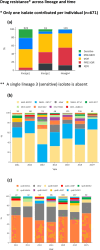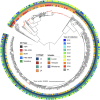Whole genome sequencing analysis of Mycobacterium tuberculosis reveals circulating strain types and drug-resistance mutations in the Philippines
- PMID: 39179783
- PMCID: PMC11344074
- DOI: 10.1038/s41598-024-70471-x
Whole genome sequencing analysis of Mycobacterium tuberculosis reveals circulating strain types and drug-resistance mutations in the Philippines
Abstract
The Philippines is a high-incidence country for tuberculosis, with the increasing prevalence of multi- (MDR-TB) and extensively-drug (XDR-TB) resistant Mycobacterium tuberculosis strains posing difficulties to disease control. Understanding the genetic diversity of circulating strains can provide insights into underlying drug resistance mutations and transmission dynamics, thereby assisting the design of diagnostic tools, including those using next generation sequencing (NGS) platforms. By analysing genome sequencing data of 732 isolates from Philippines drug-resistance survey collections spanning from 2011 to 2019, we found that the majority belonged to lineages L1 (531/732; 72.5%) and L4 (European-American; n = 174; 23.8%), with the Manila strain (L1.2.1.2.1) being the most prominent (475/531). Approximately two-thirds of isolates were found to be at least MDR-TB (483/732; 66.0%), and potential XDR-TB genotypic resistance was observed (3/732; 0.4%), highlighting an emerging problem in the country. Genotypic resistance was highly concordant with laboratory drug susceptibility testing. By finding isolates with (near-)identical genomic variation, five major clusters containing a total of 114 isolates were identified: all containing either L1 or L4 isolates with at least MDR-TB resistance and spanning multiple years of collection. Closer inspection of clusters revealed transmission in prisons, some involving isolates with XDR-TB, and mutations linked to third-line drug bedaquiline. We have also identified previously unreported mutations linked to resistance for isoniazid, rifampicin, ethambutol, and fluoroquinolones. Overall, this study provides important insights into the genetic diversity, transmission and circulating drug resistance mutations of M. tuberculosis in the Philippines, thereby informing clinical and surveillance decision-making, which is increasingly using NGS platforms.
© 2024. The Author(s).
Conflict of interest statement
The authors declare no competing interests.
Figures



References
-
- WHO. Global Tuberculosis Report 2021 (WHO, 2021).
MeSH terms
Substances
Grants and funding
LinkOut - more resources
Full Text Sources

